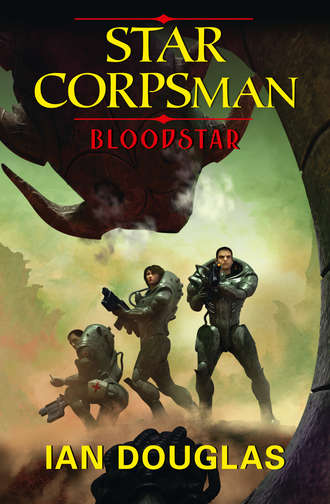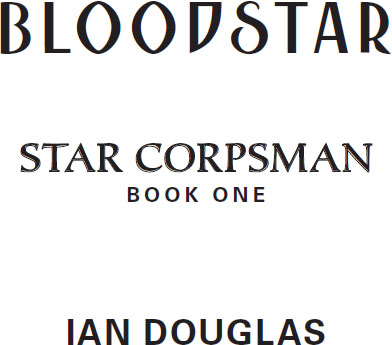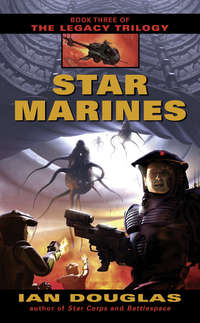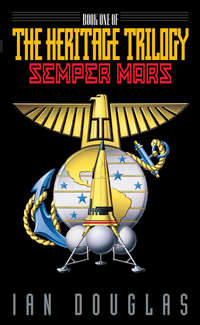
Полная версия
Bloodstar



As always, now and forever, Brea
Table of Contents
Title Page
Dedication
The Qesh were solidly in control.
Chapter One
Chapter Two
Chapter Three
Chapter Four
Chapter Five
Chapter Six
Chapter Seven
Chapter Eight
Chapter Nine
Chapter Ten
Chapter Eleven
Chapter Twelve
Chapter Thirteen
Chapter Fourteen
Chapter Fifteen
Chapter Sixteen
Chapter Seventeen
Chapter Eighteen
Chapter Nineteen
Chapter Twenty
Chapter Twenty-One
Chapter Twenty-Two
Chapter Twenty-Three
Chapter Twenty-Four
Epilogue
Star Corpsman Timeline
Star Corpsman Glossary
By Ian Douglas
Copyright
About the Publisher
The Qesh were solidly in control.
There were armed guards standing at several busy intersections, and small groups of them patrolled the corridors like cops on a beat. The humans we saw watched the patrolling Qesh with expressions ranging from boredom to terror; no one tried to talk with the invaders, and for their part, the invaders didn’t seem predisposed to interfere with the human crowd.
About ten minutes passed before we started getting signal breakup, and then the image dissolved into pixels and winked out. The transmission, shifting around randomly across tens of thousands of frequencies each second, probably couldn’t be monitored by the Qesh, but it could be blocked, by tens of meters of solid rock if nothing else. What we received before that happened, though, had been useful.
And disturbing. If the humans were cooperating with the Qesh, had they already given the invaders access to their computer records?
Had the Qesh already learned the location of Earth?
And how could we find out if they had?
Chapter One
I’M JUST GLAD I’M NOT AFRAID OF HEIGHTS.
Well, at least not much.
Our Cutlass hit atmosphere at something like 8 kilometers per second, bleeding off velocity in a blaze of heat and ionization, the sharp deceleration clamping down on my chest like a boa constrictor with a really bad attitude. I hadn’t been able to see much at that point, and most of my attention was focused simply on breathing.
But then the twelve-pack cut loose, and my insert pod went into free fall. I was thirty kilometers up, high enough that I could see the curve of the planet on my optical feed: a sharp-edged slice of gold-ocher at the horizon, with a deep, seemingly bottomless purple void directly below. We were skimming in toward the dawn with all of the aerodynamic efficiency of falling bricks. The Cutlass scratched a ruler-straight contrail through the black above our heads, scattering chaff to help conceal our drop from enemy radar and lidar assets on the ground.
The problem with a covert insertion is that the covert part is really, really hard to pull off. The bad guys can see you coming from the gods know how far away, and you tend to make a lot of noise, figuratively speaking, when you hit atmosphere.
But that’s what the U.S. Marines—and specifically Bravo Company, 1st Battalion, the Black Wizards—do best.
“Deploying airfoil,” a woman’s voice, a very sexy woman’s voice, whispered in my head, “in three … two … one …”
Why do they make our AIs sound like walking wet dreams?
My insertion pod had been a blunt, dead-black bullet shape until now, three meters long and just barely wide enough to accommodate my combat-armored body. The shell began unfolding now, growing a set of sharply back angled delta wings. The air outside was still achingly thin, but the airfoil grabbed hold with a shock akin to slamming into a brick wall. Deceleration clamped down on me once more—that damned boa constrictor looking for breakfast again—this time with a shuddering jolt that felt like my pod was shredding itself to bits.
The external sensor feeds didn’t show anything wrong, nor did my in-head readout. I was dropping through twenty-two kilometers now, and everything was going strictly according to … what the hell is that?
Red-gold ruggedness seemed to pop up directly ahead of me, looming, night-shrouded, below—and huge, and I stifled a shrieking instant of sheer panic. It was the crest of Olympus Mons, the very highest, most easterly slopes catching the rays of the Martian dawn long before sunrise reaches the huge mountain’s base. That twenty-two kilometers, I realized with a shudder, was measured from the areodetic datum, the point that would mark sea level on Mars if the planet actually had seas.
Olympus Mons, the biggest volcano in the solar system, rises twenty-one kilometers from the datum, three times the elevation of Everest, on Earth, and fully twice the height of the volcano Mauna Kea as measured from the ocean floor. I was skimming across the six nested calderas at the summit now, the rocky crater floor a scant couple of kilometers beneath my fast-falling pod. The calderas’ interior deeps were still lost in midnight shadow, but the eastern escarpment, seemingly suspended in a mass of wispy white clouds, caught the light of the shrunken rising sun, and from my vantage point it looked like those vertical rock cliffs were about to scrape the nanomatrix from my pod’s belly. In another moment, however, the escarpment was past, the 80-kilometer-wide caldera dropping behind with startling speed.
The plan, I’d known all along, was to skim just above the volcanic summit, a simple means of foxing enemy radar, but I’d not been ready for the visual reality of that near miss. My pod was totally under AI control, of course, the sentient software flexing my delta wings in rapid shifts far too fast for a mere human brain to follow. The pilot was taking me lower still, until the escarpments behind loomed above, rather than below.
Olympus Mons is huge, covering an area about the size of the state of Arizona, and that means it’s also flat, despite the summit’s dizzying altitude. The average slope is only about five degrees, and you can be standing halfway up the side of the mountain and not even be aware of it.
The slope was enough, though, that it put the bulk of Mount Olympus behind us, helping to shield us from enemy sensors ahead as we glided into the final phase of our descent. The active nano coating on the hulls of our pods drank radar, visible light—everything up through hard X-rays—giving us what amounted to invisibility. But no defense is perfect. If the enemy had known what he was doing, he’d have had whole sensory array farms across the mountain’s broad summit—not to mention point-defense lasers and antiship CPB batteries.
Hell, maybe they did and we were already dead in their crosshairs. My sensors weren’t picking up any hostile interest, though. I wished I could talk to the others, compare technical notes, but Captain Reichert would have burned me out of the sky himself for breaking comm silence.
Follow the download. Ride your pod down. Leave the thinking to the AIs. They know a hell of a lot more about it than you do.
Two hundred kilometers farther, and the base escarpment of Olympus Mons, a sheer five-kilometer cliff, slipped past in the darkness. Across the Tharsis bulge now, still descending, beginning a shuddering weave through the predawn sky to bleed off my remaining speed. The three-in-a-row volcanoes of the Tharsis Montes complex slid past. Then the Tharsis highlands gave way to the broken and chaotic terrain of the Noctis Labyrinthus, a twelve-hundred-kilometer stretch of badlands where we did not want to touch down under any stretch of the imagination. I swept into the local dawn, the sun coming up directly ahead with the abruptness of a thermonuclear blast, but in total silence.
“Landing deployment in twenty seconds,” the sexy voice told me.
“Great. Any sign of bad guys picking us up?”
“Negative on hostile activity. Military frequency signals from objective appear to be normal traffic.”
“That,” I told her, “is the sweetest news I’ve heard all morning.”
Download
Mission Profile: Ocher Sands
Operation Damascus Steel/OPPLAN#5735/15NOV2245
[extract]
… while Second Platoon will deploy by squad via Cutlass TAV/AIP to LZ Damascus Blue, location 12o 26’ S, 87o 55’ W, in the Sinai Planum. Upon landing, squads will form up individually and move on assigned objectives utilizing jumpjets. Units will be under Level-3 communications silence, and will if possible avoid enemy surveillance.
Second Platoon Objective is Base Schiaparelli, located on the Ius Chasma, coordinates 7o 19’ 30.66”, 87o 50’ 46.40” W …
The Black Wizards’ LZ was on the Sinai Planum, south of Ius Chasma, some 3,500 kilometers southeast of the summit of Olympus Mons. This was the scary part, the part where everything could go pear-shaped in a big hurry if the bastard god Murphy decided to favor me with His omnipotent and manifold blessings. “Double-check me,” I told her as I ran through the final checklist.
I saw green across the board projected in my mind.
“All CA systems appear functional,” the voice told me. She hesitated, then added, “Good luck, Petty Officer Carlyle.”
And what, I wondered, did an AI know about luck? “Thanks, girlfriend,” I muttered out loud. “Whatcha doing after the war, anyway?”
“I do not understand your question.”
“Ah, it would never work anyway, you and me,” I told her, and I waited for her to dump me.
Half a kilometer above the red-ocher desert floor, my AIP-81 insertion pod peeled open beneath and around me as if at the tug of a giant zipper, and abruptly I was in the open air and falling toward the Martian surface.
But not far. The delta-winged pod continued to open somewhere above me, unfolding into an improbably large triangular airfoil attached by buckyweave rigging and harness to my combat armor. The jolt when the wing deployed fully felt like it was going to yank me back into orbit. The ground was rushing past, and up, at a sickening pace, and I resisted the urge to crawl up the rigging to escape the blur of rock and sand.
Then the autorelease fired and the harness evaporated. My backpack jets kicked in, the blast shrill and almost inaudible in the thin atmosphere, kicking up a swirl of pale dust beneath my boots as they dropped to meet their up-rushing shadows.
I hit as I’d been trained, letting the armor take the jolt, relaxing my knees, letting myself crumple with the impact.
And I was down.
Down and safe, at least for the moment. My suit showed full airtight integrity, I couldn’t feel any pain, no broken bones or sprains or strains from an awkward landing. I stood up, just a little shaky on my feet, and took in the broad expanse of the Martian landscape, brown and rust-ocher sand and gravel beneath a vast and deep mid-morning sky, ultramarine above, pink toward the horizon.
I was alone. Even my girlfriend was gone, the circuitry that had maintained her abbreviated personality nano-D’ed into microscopic dust.
Well, not entirely alone. Somewhere out there in all that emptiness were forty-seven men and women, the rest of my Marine insertion platoon.
First things first. Navy Hospital Corpsmen are the combat medics of the Marine Corps, but our technical training makes us the sci-techs of Marine advance ops as well. Planetology, local biology and ecosphere dynamics, atmosphere chemistry—I was responsible for all of it on this mission, at least so far as Squad Bravo was concerned.
I knew what the answers would be. This was Mars, after all, and humans had been living here for a couple of centuries, now. But I drew a test sample into my ES-80 sniffer and ran the numbers anyway. Do it by the download.
Carbon dioxide, 95 percent, with 2.7 percent nitrogen, 1.6 percent argon, and a smattering of other molecular components, all at 600 pascals, which is less than one percent of the surface atmospheric pressure on Earth. Temperature a brisk minus 60 degrees Celsius. Exotic parabiochemistries powered by the unfiltered UV from the distant sun. Thirty parts per billion of methane and 130 ppb of formaldehyde—that was from the microscopic native critters living at the lower permafrost boundaries underground, the reason we’d abandoned plans to terraform the place. Gotta keep Mars safe and pristine for the alien wee beasties, after all.
I recorded the data, exactly as if we had no idea what was on Mars, and uploaded it to the squadnet. I also needed to—
“Corpsman, front!” The voice of Corporal Lewis came over my com link. “Marine down!”
Shit! “Moving,” I said, my voice sounding uncomfortably loud within the confines of my helmet. I called up the tacsit display on my in-head, getting my bearings. There were ten green dots—the one at dead center was me—and one off to the side flashing red. I turned, getting a bearing. Private Colby was that way, 2 kilometers away. Corporal Lewis was with him.
“I’ve got you on my display,” I told Colby. Under a Level-3 comm silence, we were using secure channels—tightly beamed IR laser-com signals relayed both line of sight and through our constellation of micro comsats in orbit. The setup allowed short-range communications with little chance of the enemy tapping in unless he was directly in the path of one of our beams, but we were still supposed to keep long-range chatter to an absolute minimum.
I took a short and lumbering run, kicked in my jets, and flew.
Service Manual Download
Standard-Issue Military Equipment
MMCA Combat Armor, Mk. 10
[extract]
… including alternating ultra-light layers of carbon buckyweave fiber and titanium-ceramic composite with an active-nano surface programmable by the wearer for either high or low visibility, or for albedo adjustments for thermal control. Power is provided by high-density lutetium-polonium batteries, allowing approximately 300 hours service with normal usage depending upon local incident thermal radiation.
Internally accessible stores carry up to three days’ rations of air, water, and food, which can be extended using onboard extractors and nanassemblers. Service stores of cryogenic hydrogen and oxygen [crH2/crO2] can be carried to further extend extraction/assembled expendables.
Combat armor mass averages 20–25 kg, though with full expendables load-out this may increase to as much as 50 kilos …
Flight Mode
Mk. 10 units are capable of short periods of flight depending on local gravity, or of jet-assisted maneuvers in a microgravity environment. The M287 dorsal-mounted jumpjet unit uses metastable N-He64, commonly called meta, as propellant, stored in crogenically inert high-pressure backpack tanks.
Proper maintenance of meta HP fuel tanks is vital for safe storage, transport, and operation of jumpjet units …
Marine combat armor isn’t really designed for flight, especially in-atmosphere, but the Martian air is thin enough that it’s close to hard vacuum, and my “flight” was more a series of long, low bounds across the rocky, dark red-brown terrain, aided by the low gravity—about .38 of Earth normal. That meant I got more boost for my buck, and just a few quick thruster bursts brought me down in the boulder-strewn field where Private Colby was curled up on the sand, his arms wrapped around his left shin, with Corporal Lewis at his side.
I’d checked his readouts during my flight, of course—at least when I wasn’t watching my landings to avoid doing what I suspected Colby had just done to himself—landing like shit and breaking something. Just because you weigh less than half what you do on Earth here doesn’t mean you don’t still have your normal mass, plus the mass of your combat armor. Bones can only take so much stress, and a misstep can snap one. Colby’s data feed showed he was conscious and in pain, respiration and heart rate high, suit intact. Thank the gods for that much, anyway. A breach in the suit brings with it its own list of headaches.
“He hit a rock, Doc!” Lewis said, looking up as I slid to a halt in loose sand. “He hit a rock coming down!”
“So I see. How you doing, Colby?”
“How do you fucking goddamn think I’m fucking feeling goddamned stupid-ass bullshit questions—”
I had already popped the cover on Colby’s armor control panel, located high on his left shoulder, and was punching in my code. Before I hit the SEND key, though, I hit the transparency control for his visor, then rolled him enough that I could peer through his visor and into his eyes. “Look at me, Colby!” I called. “Open your eyes!”
His eyes opened, and I looked at his pupils, comparing one with the other. They were the same size. “Your head hurt at all?” I asked.
“Goddamn it’s my fucking leg not my head Doc will you fucking do something fer chrissakes—”
Good enough. I hit the SEND key, and Colby’s suit auto-injected a jolt of anodynic recep blockers into his carotid artery. Nananodyne can screw you up royally if you have a head injury, which was why I’d checked his pupils and questioned him first.
“Can we get him up on his feet, Doc?” Lewis asked.
“Don’t know yet” I said. “Gimme a sec, okay?”
I jacked into Colby’s armor and instituted a full scan. Infrared sensors woven into his skinsuit picked up areas of heat at various wavelengths and zipped a picture of his body into my head. The data confirmed no pressure leaks—those would have shown up as cold—but there was plenty of bright yellow inflammation around his left shin. No sign of bleeding; that would have appeared as a hot spot, spreading out and cooling to blue inside the greave. Colby was relaxing moment by moment. Those nanonarcs target the thalamus and the insular cortex of the brain, switching off the doloric receptors and blocking incoming pain messages.
Heart rate 140 and thready, BP 130 over 80, respiration 28 and shallow, and elevating adrenaline and noradrenaline, which meant an onset of the Cushing reflex. His body temp was cooling at the extremities which meant he was on the verge of going shocky as blood started pooling in his core. I told his suit to manage that—boosting the heat a bit and gently relaxing the constriction in the arteries leading to the head to keep his brain fed.
That would hold him until I could take a close-up look at his leg.
In the old days, there wouldn’t have been much I could have done except locking his combat armor, turning his left greave into an emergency splint. If the patient wasn’t wearing full armor, you used whatever was available, from a ready-made medical wrap that hardens into a splint when you run an electric current through it, to simply tying the bad leg to the good, immobilizing it. By keying a command into Colby’s mobility circuits, the armor itself would clamp down and hold the broken bones in place, but there was one more thing I could try in order to get him up and mobile.
I reached into my M-7 kit and removed a small hypo filled with 1 cc of dark gray liquid. The tip fit neatly into a valve located beside his left knee, opening it while maintaining the suit’s internal pressure, and when I touched the button, a burst of high-pressure nitrogen gas fired the concoction through both his inner suit and his skin. Nanobots entered his bloodstream at the popliteal artery, activating with Colby’s body heat and transmitting a flood of data over my suit channels. I thoughtclicked several internal icons, deactivating all of the ’bots that were either going the wrong way or were adhering to Colby’s skinsuit or his skin, and focused on the several thousand that were flowing now through the anterior and posterior tibial arteries toward the injury.
I wanted to go inside … but that would have given me a bit too intimate of a view, too close and too narrow to do me any good. What I needed to see was the entire internal structure of the lower leg—tibia and fibula; the gastrocnemius, soleus, and tibialis anterior muscles; the tibialis anterior and posterior tibial arteries; and the epifascial venous system. I sent Program 1 to the active ’bots, and they began diffusing through capillaries and tissue, adhering to the two bones, the larger tibia and the more slender fibula off to the side, plating out throughout the soft tissue, and transmitting a 3-D graphic to my in-head that showed me exactly what I was dealing with.
I rotated the graphic in my mind, checking it from all angles. We were in luck. I was looking at a greenstick fracture of the tibia—the major bone that runs down the front of the shin, knee to ankle. The bone had partially broken, but was still intact on the dorsal surface, literally like a stick half broken and bent back. The jagged edges had caused some internal bleeding, but no major arteries had been torn and the ends weren’t poking through the skin. The fibula, the smaller bone running down the outside of the lower leg, appeared to be intact. The periosteum, the thin sheath of blood vessel- and nerve-rich tissue covering the bone, had been torn around the break of course, which was why Colby had been hurting so much.
“How’s he doing, Doc?”
The voice startled me. Gunny Hancock had come up out of nowhere and was looking over my shoulder. I’d had no idea that he was there.
“Greenstick fracture of the left tibia, Gunny,” I told him. “Shinbone. I have him on pain blockers.”
“Can he walk?”
“Not yet. He should be medevaced. But I can get him walking if you want.”
“I want. The LT wants to finish the mission.”
“Okay. Ten minutes.”
“Shit, Gunny,” Colby said. “You heard Doc. I need a medevac!”
“You’ll have one. Later.”
“Yeah, but—”
“Later, Marine! Now seal your nip-sucker and do what Doc tells ya!”
“Aye, aye, Gunnery Sergeant.”
I ignored the byplay, focusing on my in-head and a sequence of thoughtclicks routing a new set of orders to the ’bots in Colby’s leg. Program 5 ought to do the trick.
“How you feeling, Colby?” I asked.
“The pain’s gone,” he said. “The leg feels a bit weak, though.” He flexed it.
“Don’t move,” I told him. “I’m going to do some manipulation. It’ll feel funny.”
“Okay …” He didn’t sound too sure of things.
Guided by the new program download, some hundreds of thousands of ’bots, each one about a micron long—a fifth the size of a red blood cell—began migrating through soft tissue and capillaries, closing in around the broken bone until it was completely coated above and below the break. In my in-head, the muscles and blood vessels disappeared, leaving only the central portion of the tibia itself visible. I punched in a code on Colby’s armor alphanumeric, telling it to begin feeding a low-voltage current through the left greave.
Something smaller than a red blood cell can’t exert much in the way of traction unless it’s magnetically locked in with a few hundred thousand of its brothers, and they’re all pulling together. In the open window in my head, I could see the section of bone slowly bending back into a straight line, the jagged edges nesting into place. The movement would cause a little more periosteal damage—there was no way to avoid that—but the break closed up neatly.









